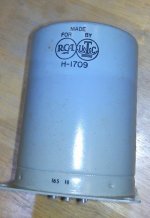You can check RCA radios, amps RCA, where there are OT in schematics and part lists, like: https://www.google.bg/search?q=RCA+...source=hp&gfe_rd=cr&ei=ChPuU7XmNs7c8geIwoCQDQ
You can check RCA radios, amps RCA, where there are OT in schematics and part lists, like: https://www.google.bg/search?q=RCA+...source=hp&gfe_rd=cr&ei=ChPuU7XmNs7c8geIwoCQDQ
Many thanks,
Finding info on these will be difficult. By their appearance I would say that these are spares for some piece of RCA broadcast equipment, circa 1945 - 1960. Most likely audio transformers and not power transformers - I don't remember ever seeing any power transformers that look like that in RCA equipment.
I can't tell exactly how big they are, but they may have been used in a mixing board, or a broadcast transmitter, or compressor/limiter. If they are bigger than about 2.5" in diameter they could be interstage transformers for an AM transmitter modulator, or OPTs for a distribution or monitor amp. If smaller, probably line output transformers? They look too big for input or mic transformers.
Their appearance is similar to the CG-series, made from the mid 40's through about 1975. You can get some idea of what commercial transformers were in that case by looking at the 1960 or 1970 UTC catalog, which you can find here: Antique Transformer and Parts Catalogs and Specifications
Good luck!
Pete
I can't tell exactly how big they are, but they may have been used in a mixing board, or a broadcast transmitter, or compressor/limiter. If they are bigger than about 2.5" in diameter they could be interstage transformers for an AM transmitter modulator, or OPTs for a distribution or monitor amp. If smaller, probably line output transformers? They look too big for input or mic transformers.
Their appearance is similar to the CG-series, made from the mid 40's through about 1975. You can get some idea of what commercial transformers were in that case by looking at the 1960 or 1970 UTC catalog, which you can find here: Antique Transformer and Parts Catalogs and Specifications
Good luck!
Pete
Well one can find the connections via simple resistance checks. Make a chart.
Then one can assume the higher Z vs. lower Z windings via DCR - add to the chart.
Next assume based on the high vs low Z winding resistance which ought to be a primary and which is a secondary. Of course for a 1:1 transformer or similar ratios, the windings will look similar which will make it somewhat more difficult to figure it all out.
Next apply a low voltage AC signal, a simple transformer is fine and 10volts or 1 volt is very handy since the ratios are then simple and need no calculation. This will tell you the turns ratio(s). Add to the chart.
Now you can apply the formula for turns ratio to impedance and get a rough idea of what the transformer was intended to do.
You can estimate the power level by the case/core size compared to standard UTC lines, and even the pinout *may* be similar or the same as a standard UTC unit.
Then one can assume the higher Z vs. lower Z windings via DCR - add to the chart.
Next assume based on the high vs low Z winding resistance which ought to be a primary and which is a secondary. Of course for a 1:1 transformer or similar ratios, the windings will look similar which will make it somewhat more difficult to figure it all out.
Next apply a low voltage AC signal, a simple transformer is fine and 10volts or 1 volt is very handy since the ratios are then simple and need no calculation. This will tell you the turns ratio(s). Add to the chart.
Now you can apply the formula for turns ratio to impedance and get a rough idea of what the transformer was intended to do.
You can estimate the power level by the case/core size compared to standard UTC lines, and even the pinout *may* be similar or the same as a standard UTC unit.
I agree with everything above, but I'd like to mention that I've never seen an RCA by UTC audio transformer that used an "H" prefix.
I go way back with RCA tube audio gear, having bought lots of it from wrecking yards, priced by the pound, back in the 1980's.
My WE collector friends laughed at me, but in hindsight, I wish I'd bought more of it!
I go way back with RCA tube audio gear, having bought lots of it from wrecking yards, priced by the pound, back in the 1980's.
My WE collector friends laughed at me, but in hindsight, I wish I'd bought more of it!
- Status
- Not open for further replies.
- Home
- Amplifiers
- Tubes / Valves
- UTC Transformer

